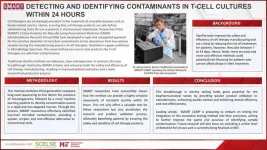(Press-News.org) Traditional sterility testing methods for the presence of bacteria and fungi in T-cell cultures are time-consuming, taking from seven up to 14 days, while this novel method takes only up to 24 hours
Researchers combined advanced long-read nanopore sequencing techniques and machine learning to ensure accuracy and speed in detecting and identifying sample sterility status and microbial species present in T-cell cultures
This breakthrough has the potential to transform sterility assurance in biopharmaceutical manufacturing, leading to better patient outcomes by accelerating the process of getting cell therapy treatments to patients
Singapore, 27 November 2023 - Researchers from Critical Analytics for Manufacturing Personalized-Medicine (CAMP) Interdisciplinary Research Group (IRG) at Singapore-MIT Alliance for Research and Technology (SMART), MIT’s research enterprise in Singapore, in collaboration with Singapore Centre for Environmental Life Sciences Engineering (SCELSE) and Massachusetts Institute of Technology (MIT), have developed a novel method capable of identifying contaminants in T-cell cultures within 24 hours. This method, adept at detecting low-abundance levels of microbial contaminants while effectively determining their types, ensures that therapeutic products like T-cell therapies are safe from contamination, with a faster turnaround – reducing the risk for patients and speeding up the process of getting these treatments to those in need.
Cell therapies are increasingly prevalent in the treatment of incurable diseases. For example, chimeric antigen receptor T-cells (CAR-T) are used for the treatment of blood-related cancers. Because these living medicines cannot be sterilised, assuring that cell therapy products are safe from microbial contamination before administering them for use in patients is of paramount importance.
Current traditional sterility tests help to guarantee microbial safety by ensuring that medical treatments are free from harmful contaminants. They improve the safety and efficiency of cell therapy manufacturing, playing an essential role in reducing the risk of treatments for patients. These traditional sterility methods are laborious and take between seven to 14 days; hence, faster methods could potentially be lifesaving for patients who cannot afford delays in their treatment. SMART CAMP’s breakthrough method could enhance both the safety and efficiency of cell therapy manufacturing, resulting in improved patient outcomes and a more streamlined production process.
In a paper titled “Machine learning-based detection of adventitious microbes in T-cell therapy cultures using long-read sequencing”, published recently in the journal Microbiology Spectrum, SMART researchers detailed a novel method to detect contaminants in T-cell cultures within 24 hours, significantly faster than traditional methods that can take 7-14 days. The researchers employed cutting-edge technology like third-generation nanopore long-read sequencing and DNA extraction alongside machine learning algorithms to improve the overall process and ensure accuracy and speed. The primary objective is to differentiate between clean and contaminated samples and pinpoint the organisms most likely causing the contamination.
SMART’s novel method utilises third-generation nanopore long-read sequencing methodology to identify harmful microorganisms, followed by an advanced machine learning algorithm, computational analysis and optimisation. Through this process, the researchers successfully identified the presence and types of microbial contaminants even at low abundance levels while also achieving this more quickly than standard compendial tests.
“The practical application of this discovery is vast; it offers faster product validation for biopharmaceutical manufacturers, reducing downtime and potentially accelerating product-to-market timelines. These advancements hold significant promise for the biopharmaceutical industry, as they not only enhance quality control but also improve overall efficiency and cost-effectiveness, ultimately benefiting patients by ensuring the safety and reliability of cell therapy products,” said Dr James Strutt, Senior Postdoctoral Associate at SMART CAMP and first author of the paper.
The research was presented at the A*STAR Mini Symposium in the Advances in Cell and Gene Therapy (A*CGT) in Singapore, and at the 31st Annual Intelligent Systems For Molecular Biology and the 22nd Annual European Conference on Computational Biology held in Lyon, France, by Dr James Strutt.
SMART CAMP is preparing to initiate testing to evaluate the integration of the novel T-cell sterility test into their processes and to further enhance the accuracy of contamination detection, while future research will focus on providing a similar level of detection for viruses and is currently being finalised at MIT. This advancement aims to provide more robust and dependable sterility assessments, in line with the SMART researchers’ core goal of swiftly and accurately identifying sample contamination.
“Our rapid method offers a more efficient way to not only detect microbial contamination, but identify the contaminating species. We demonstrated that this method can deliver a high-sensitivity microbial sterility assessment within just 24 hours, providing a valuable tool for researchers and hopefully practitioners in the near future,” added co-corresponding author Dr Stacy L. Springs, Principal Investigator at SMART CAMP and Executive Director at MIT Center for Biomedical Innovation.
The research is carried out by SMART and supported by the National Research Foundation (NRF) Singapore under its Campus for Research Excellence And Technological Enterprise (CREATE) programme.
###
END
· AI tool could reduce disparities for patients who are diagnosed in community settings
· Non-cancerous cells can play an important role in sustaining or inhibiting cancer growth
· One in eight U.S. women will receive a breast cancer diagnosis in her lifetime
CHICAGO --- A new AI (Artificial Intelligence) tool may make it possible to spare breast cancer patients unnecessary chemotherapy treatments by using a more precise method of predicting their outcomes, reports ...
About The Study: School shooting incidents in the U.S. were typically executed using low- and moderate-powered firearms, according to this analysis of data from 262 adolescents who discharged firearms in 253 school shootings spanning 26 years. These weapons were most frequently stolen from family members or relatives of the perpetrators. These findings may significantly influence discussions around gun control policy, particularly in advocating for secure firearm storage to reduce adolescents’ access to weapons.
Authors: Brent R. Klein, Ph.D., of the University of South Carolina in Columbia, is the corresponding author.
To access ...
About The Study: Excess cardiovascular mortality among former smokers was about one-third that of continuing smokers within the first decade after quitting, and the cardiovascular mortality rate of former smokers was similar to that of never smokers 20 to 29 years after quitting in this study of 438,000 U.S. adults. These findings emphasize that with sustained cessation, cause-specific mortality rates among former smokers may eventually approximate those of never smokers.
Authors: Blake Thomson, D.Phil., of the Stanford University School of Medicine in Stanford, California, is the corresponding author.
To access the embargoed study: Visit our For The Media website at ...
Brain Boost: Can a Coach Help Elders at Risk for Alzheimer’s?
Study shows cognitive improvements when participants keep active and socially engaged, control blood pressure and diabetes.
As more medications move towards federal approval for Alzheimer’s disease, a new study led by researchers at UC San Francisco and Kaiser Permanente Washington has found that personalized health and lifestyle changes can delay or even prevent memory loss for higher-risk older adults.
The two-year study compared cognitive ...
An international team has shown that the injection of a type of stem cell into the brains of patients living with progressive multiple sclerosis (MS) is safe, well tolerated and has a long-lasting effect that appears to protect the brain from further damage.
The study, led by scientists at the University of Cambridge, University of Milan Bicocca and Hospital Casa Sollievo della Sofferenza (Italy), is a step towards developing an advanced cell therapy treatment for progressive MS.
Over 2 million people live with MS worldwide, ...
PITTSBURGH, Nov. 27, 2023 – Common neuropsychiatric symptoms that doctors see in Alzheimer’s disease patients originate from brain inflammation rather than amyloid and tau proteins, report University of Pittsburgh School of Medicine researchers today in JAMA Network Open.
The finding strengthens mounting evidence for the role of neuroinflammation in Alzheimer’s progression and suggests new pathways for the development of therapies targeting neurological symptoms of the disease.
“Neuropsychiatric symptoms such as irritability, agitation, anxiety and depression are among the most difficult ...
Nearly a third of the world’s mine tailings are stored within or near protected conservation areas, University of Queensland research has found.
A study led by UQ’s Bora Aska, from the Sustainable Minerals Institute and School of the Environment, said these waste facilities pose an enormous risk to some of earth’s most precious species and landscapes.
“Mine tailings contain the waste and residue that remains after mineral processing, and the storage facilities built to contain it are some of the world’s largest engineered structures,” Ms Aska said.
“We found of the 1,721 disclosed tailings ...
Whether infants at five months of age look mostly at faces or non-social objects such as cars or mobile phones is largely determined by genes. This has now been demonstrated by researchers at Uppsala University and Karolinska Institutet. The findings suggest that there is a biological basis for how infants create their unique visual experiences and which things they learn most about. The study has been published in the scientific journal Nature Human Behaviour.
The way in which we explore our environment with our eyes affects what we notice, think about and learn. The new study analysed preference for faces versus non-social objects in ...
A Perspective article published today in Nature Geoscience tackles the longstanding issue of gender representation in science, focusing on the field of ice core science. Prior work has shown that despite progress toward gender parity over the past fifty years1, women continue to be significantly underrepresented within the discipline of Earth sciences2 and receive disproportionately fewer opportunities for recognition, such as invited talks, awards, and nominations3. This lack of opportunity can have long-term negative impacts on women’s careers. To help address these persistent gender gaps, the study evaluates patterns related to women’s publication in ice core science over the ...
Ahab hunting down Moby Dick. Wile E. Coyote chasing the Road Runner. Learning Latin. Walking over hot coals. Standing in a long line for boba tea or entrance to a small, overpriced clothing retail store. Forking up for luxury nonsense.
What do these activities have in common? They’re all examples of the overvaluation of what economists call “sunk costs”: the price you’ve already irretrievably paid in time, money, effort, suffering or any combination of them for an item, an experience or a sense of self-esteem.
It’s a ...





